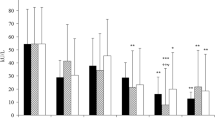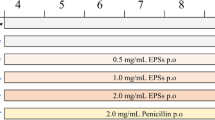Abstract
Reactive oxygen species (ROS) are potent mediators of inflammatory disorders and may be of pathophysiological importance in S. typhimurium induced tissue damage. This study was carried out to investigate if ROS play a role in mediating the enterocyte damage during in vitro exposure to Salmonella typhimurium enterotoxin (S-LT). The ROS generation was detected by measuring the changes in the enterocyte arachidonic acid (AA) metabolism (measured indirectly by estimating the level of enterocyte damage in the absence and presence of the cyclooxygenase inhibitor, indomethacin) and xanthine oxidase activity. The enterocyte damage was estimated by measuring the changes in the level of lipid peroxidation and cell viability. The results obtained showed that the exposure of isolated rat enterocytes to S-LT resulted in an increased XO activity; an increased arachidonic acid metabolism, dose and time dependent increase in the level of lipid peroxidation and decreased cell viability. Lipid peroxidation decreased and cell viability increased in the presence of the antioxidant enzymes superoxide dismutase (SOD) or catalase. Thus the in vitro exposure of the enterocytes to S-LT is accompanied by an increased generation of ROS which may induce the lipid peroxidation of the enterocyte membrane thereby leading to a loss of cell viability.
Similar content being viewed by others

References
Giannella RA, Formal SB, Dammin GJ, Collins H: Pathogenesis of salmonellosis. Studies of fluid secretion, mucosal invasion and morphologic reaction in the rabbit ileum. J Clin Invest 52: 441–453, 1973
Prasad R, Chopra AK, Chary P, Peterson JW: Expression arid characterization of the cloned Salmonella typhimurium enterotoxin. Microb Pathogen 13: 109–121, 1992
Koo FCW, Peterson JW, Houston CW, Molina N: Pathogenesis of experimental salmonellosis. Inhibition of protein synthesis by cytotoxin. Infect Immun 43: 93–100, 1984
Takeuchi A: Electron microscope studies of experimental Salmonella infection I. Penetration of the intestinal epithelium by Salmonella typhimurium. Am J Pathol 50: 109–136, 1967
Gianella RA, Gots RE, Charney AN, Greenough WB, Formal SB: Pathogenesis of Salmonella mediated intestinal fluid secretion. Activation of adenylate cyclase and inhibition by indomethacin. Gastroenterology 69: 1238–1245, 1975
Khurana S, Ganguly NK, Panigrahi D, Khullar M, Walia BNS: Studies on mechanisms of Salmonella typhimurium enterotoxin-mediated diarrhoea. Biochim Biophys Acta 1097: 171–176, 1991
Mehta A, Singh S, Ganguly NK: Impairment of intestinal mucosal antioxidant defense system during Salmonella typhimurium infection. Dig Dis Sci 43: 1998
Dellacorte E, Stripe F: The regulation of rat liver xanthine oxidase. Involvement of thiol groups in the conversion of the enzyme activity from dehydrogenase (type D) into oxidase (type O) and purification of the enzyme. Biochem J 126: 739–745, 1972
Pryor WA: Free radicals and lipid peroxidation. What they are and how they got that way. In: Natural antioxidants in human health and disease. B. Frie (ed). Academic Press, Orlando FL, 1994, pp 1–24
Wallis TS, Starkey WG, Stephen J, Haddon SJ, Osborne MP, Candy DCA: Enterotoxin production by Salmonella typhimurium strains of different virulence. J Med Microbiol 21: 19–23, 1986
Houston CW, Davis CP, Peterson JW: Salmonella toxin synthesis is unrelated to the presence of temperate bacteriophages. Infec Immun 35: 749–751, 1982
De SN, Chatterji DN: An experimental study on the mechanism of action of Vibrio cholerae on the intestinal mucous membrane. J Pathol Bacteriol 66: 559–562, 1953
Evans DG, Evans DJ, Gorbach SC: Identification of enterotoxigenic Escherichia coli and serum antitoxin activity by the vascular permeability assay. Infect Immun 8: 731–735, 1973
Peterson JW, Houston CW, Koo FCW: Influence of culture conditions on mitomycin C-mediated bacteriophage induction and release of Salmonella toxin. Infect Immun 32: 232–242, 1981
Pinkus LM: Separation and use of enterocytes. In: Methods in enzymology 77: 154–162, 1981
Toyoda S, Lee PC, Labenthol E: Physiological factor controlling release of enterokinase from rat enterocytes. Dig Dis Sci 30: 1174–1180, 1985
Stripe F, Dellacorte E: The regulation of rat liver xanthine oxidase: Conversion in vitro of the enzyme activity from dehydrogrenase (type D) to oxidase (type O). J Biol Chem 244: 3855–3863, 1969
Ohkawa H, Oshishi N, Yagi K: Reaction of linoleic acid hydroperoxide with TBA. J Lipid Res 19: 1053–1057, 1979
Recknagel RO, Glende EA: Spectrophotometric determination of lipid conjugated dienes. Meth Enzymol 105: 331–337, 1984
Vassault A: Lactate dehydrogenase. UV method with pyruvate and NADH. In: H.U. Bergmeyer (ed). Methods in enzymatic analysis. Verley, Chemie, Weinheim 3: 118–126, 1983
Lowry OH, Rosebrough NJ, Farr AL, Randall RJ: Protein measurement with Folin's phenol reagent. J Biol Chem 193: 265–275, 1951
Smith S, Grisham M, Manci E, Granger N, Kvietys P: Gastric mucosal injury in the rat. Gastroenterology 92: 950–956, 1987
Grisham MB, Hernandez LA, Granger DA: Xanthine oxidase and neutrophil infiltration in intestinal ischemia. Am J Physiol 251: G567–574, 1986
Chiu D, Lukin B, Shohet SB: Perioxidative reactions and cell biology. In: W.A. Pryor (ed). Free radicals in Biology. Academic Vol. 5., New York, 1982, p 115
Seiichi T, Kondo T, Yoshida K, Hirokawa J, Ohtsuka Y, Kawakami Y: Effect of insulin on impaired antioxidant activities in aortic endothelial cells diabetic rats. Metabolism 41: 1053–1055, 1992
Lee JB: The prostaglandins. In: R.W. William (ed). Textbook of Endocrinology. Saunders, Philadelphia, 1974, pp 854–868
Gustafson C, Lindahl M, Tagesson C: Hydrogen peroxide stimulates phospholipase A2–mediated arachidonic acid release in cultured intestinal epithelial cells (INT407). Scand J Gastroenterol 26: 237–247, 1991
Rask-Madsen J: The role of eicosanoids in the gastrointestinal tract. Scand J Gastroenterol 22 (Suppl 127): 7–19, 1987
Hemier ME, Cook HE, Lands WEM: Prostaglandin biosynthesis can be triggered by lipid peroxides. Arch Biochem Biophys 193: 340–345, 1979
Otamiri T: Oxygen radicals, lipid peroxidation, and neutrophil infiltration after small-intestinal ischemia and reperfusion. Surgery 105: 593–597, 1989
Halliwell B: Oxidants and the central nervous system: Some fundamental questions: Is oxidant damage relevant to Parkinson's disease, Alzheimer's disease, traumatic injury or stroke? Acta Neurol Scand 80 (suppl 26): 23–33, 1989
Nalini S, Balasubramaniam KA: Effect of luminal exposure of oxidants on intestinal mucosal lipid peroxidation and absorptive function. Scand J Gastroenterol 25: 281–284, 1993
Miccadei S, Kyle ME, Gilfor D, Farber JL: Toxic consequence of the abrupt depletion of glutathione in cultured rat hepatocytes. Arch Biochem Biophys 265: 311–320, 1988
Keshavarzian A, Sedghi S, Kanofsky J, Lis T, Robinson C, Ibrahim C, Winship D: Excessive production of reactive oxygen metabolites by inflamed colon: Analysis by chemi luminescence probe. Gastroenterology 103: 177–185, 1992
Niwa Y, Somiay K, Michelson AM, Puget K: Effect of liposomal-encapsulated superoxide dismutase on active oxygen related disorders. Free Rad Res Commun 15: 297–301, 1991
Millar AD, Rampton DS, Chatider CL, Clatson AWD, Blades S, Coumbe A, Panetta J, Morris CJ, Blake DR: Evaluating the antioxidant potential of new treatments for inflammatory bowel disease using a rat model of colitis. Gut 39: 407–415, 1996
Emerit J, Pelletier S, Likforman J, Pasquier C, Thullier A: Phase II trial of superoxide dismutase in the treatment of Crohn's disease. Free Rad Res Commun 12–13 (pt2): 563–569, 1991
Yoshikawa T, Takahashi S, Konds M: Possible role of free radicals in chronic inflammation in the gut. EXS 62: 353–358, 1992
Bilota JJ, Wayne JD: Hydrogen peroxide enteritis, the “snow white” sign. Gastrointest Endosc 35: 428–430, 1989
Simmonds NJ, Alien RE, Stevens TJR, vanSomeren RNM, Blake DR, Rampton DS: Chemiluminescence assay of mucosal reactive metabolites in inflammatory bowel disease. Gastroenterology 103: 183–196, 1992
Scott MD, Meshnick SR, Eaton JW: Superoxide dismutase-rich bacteria. Paradoxical increase in oxidant toxicity. J Biol Chem 262: 3640–3645, 1987
Scott MD, Meshnick SR, Eaton JW: Superoxide, dismutase amplifies organismal sensitivity to ionizing radiation. J Biol Chem 264: 2498–2501, 1989
Baker SS, Campbell CL: Rat enterocyte injury by oxygen dependent processes. Gastroenterology 101: 716–720, 1991
Watson AJM, Askew JN, Sandie GI: Characterisation of oxidative injury to an intestinal cell line (HT-29) by hydrogen peroxide. Gut 35: 1575–1581, 1994
Author information
Authors and Affiliations
Rights and permissions
About this article
Cite this article
Mehta, A., Singh, S. & Ganguly, N.K. Effect of Salmonella typhimurium enterotoxin (S-LT) on lipid peroxidation and cell viability levels of isolated rat enterocytes. Mol Cell Biochem 196, 175–181 (1999). https://doi.org/10.1023/A:1006996430129
Issue Date:
DOI: https://doi.org/10.1023/A:1006996430129



